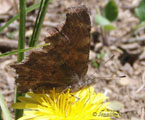Native Plants
Search for native plants by scientific name, common name or family. If you are not sure what you are looking for, try the Combination Search or our Recommended Species lists.
Betula lenta
Betula lenta L.
Sweet Birch, Cherry Birch, Black Birch, Mahogany Birch
Betulaceae (Birch Family)
Synonym(s):
USDA Symbol: BELE
USDA Native Status: L48 (N), CAN (N)
Sweet birch or cherry birch is a 50-75 ft. tree with brownish-black, cherry-like, scaly bark and reddish-brown stems. Conical in youth, the deciduous tree becomes ovoid to globular in maturity. Aromatic tree with rounded crown of spreading branches and odor of wintergreen in crushed twigs and foliage. Fall color is golden-yellow and the flower is a catkin that appears before leaf emergence.
Birch oil, or oil of wintergreen, used to flavor medicines and candy, was once obtained from the bark and wood of young trees. That wasteful process has been replaced by the manufacture of the same oil from wood alcohol and salicylic acid. The trees can be tapped like Sugar Maples (Acer saccharum) in early spring and the fermented sap made into birch beer. Of Canada's birches, sweet birch has the most dense wood. One cubic metre of air-dried wood weighs 656 kg. (Kershaw)
Plant Characteristics
Duration: PerennialHabit: Tree
Leaf Retention: Deciduous
Leaf Arrangement: Alternate
Leaf Complexity: Simple
Leaf Venation: Pinnate
Breeding System: Flowers Unisexual , Monoecious
Fruit Type: Samara
Size Notes: Up to about 75 feet tall.
Leaf: Green.
Autumn Foliage: yes
Fruit: Green.
Bloom Information
Bloom Color: Red , Yellow , Green , BrownBloom Time: Apr , May
Distribution
USA: AL , CT , DE , GA , KY , MA , MD , ME , MS , NC , NH , NJ , NY , OH , PA , RI , SC , TN , VA , VT , WVCanada: ON
Native Distribution: S. ME through NY to n.e. OH, s. though mts. to NC & AL
Native Habitat: Rich, mountain woods; cool north & east slopes
Growing Conditions
Water Use: MediumLight Requirement: Part Shade , Shade
Soil Moisture: Dry , Moist
Soil pH: Acidic (pH<6.8)
CaCO3 Tolerance: Low
Soil Description: Rich, moist, well-drained soil.
Conditions Comments: Cherry birch is resistant to bronze birch borer, but like other birches is troubled by a number of problems. Exhibits the best fall color of the commonly cultivated birches, especially in the Midwest. Do not prune until summer when the sap has stopped flowing.
Benefit
Use Wildlife: Very high.Use Other: This tree has been a source of the commercial extract known as oil of wintergreen. In taste, odor and chemical composition it is identical with the original wintergreen obtained from the plant of that name. A member of the same family as trailing arbutus. young and sapling trees were the preferred source, and it took about one hundred such to produce a single quart of the oil. The country folk sold the oil by the quart to storekeepers, who passed it on to the wholesale druggists, and these in turn refined it and used it to flavour drugs, medicines, and candy. (Peattie)
Interesting Foliage: yes
Fragrant Foliage: yes
Attracts: Birds
Butterflies and Moths of North America (BAMONA)
|
Green Comma (Polygonia faunus)  Adult Food Source |
Propagation
Description: Seeds have low viability. Germination is facilitated by exposure to light; never plant too deeply.Seed Collection: Birch seed is collected by picking the catkins while they are still green enough to hold together. They shatter easily and should be put directly into bags.
Seed Treatment: One month cold stratification compensates for light treatment.
Commercially Avail: yes
National Wetland Indicator Status
| Region: | AGCP | AK | AW | CB | EMP | GP | HI | MW | NCNE | WMVE |
| Status: | FACU | FACU | FACU | FACU |
From the National Organizations Directory
According to the species list provided by Affiliate Organizations, this plant is on display at the following locations:Delaware Nature Society - Hockessin, DE
Natural Biodiversity - Johnstown, PA
Mt. Cuba Center - Hockessin, DE
Bibliography
Bibref 1186 - Field Guide to Moths of Eastern North America (2005) Covell, C.V., Jr.Bibref 1185 - Field Guide to Western Butterflies (Peterson Field Guides) (1999) Opler, P.A. and A.B. Wright
Bibref 841 - Native Alternatives to Invasive Plants (2006) Burrell, C. C.
Bibref 400 - Natural History of Trees of Eastern & Central North America (1991) Peattie, D.C. & P. H. Landacre
Bibref 1258 - Trees of Ontario (2007) Kershaw, Linda
Search More Titles in Bibliography
Additional resources
USDA: Find Betula lenta in USDA PlantsFNA: Find Betula lenta in the Flora of North America (if available)
Google: Search Google for Betula lenta
Metadata
Record Modified: 2023-03-09Research By: TWC Staff